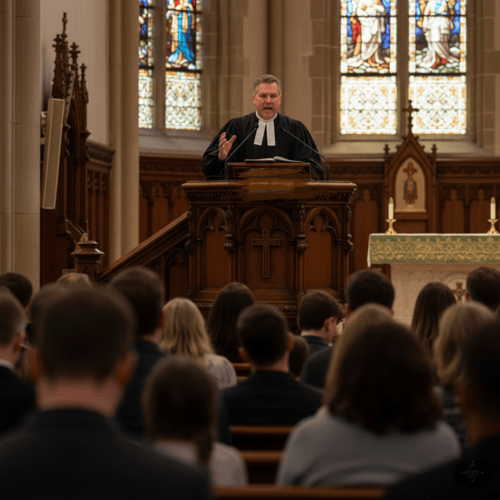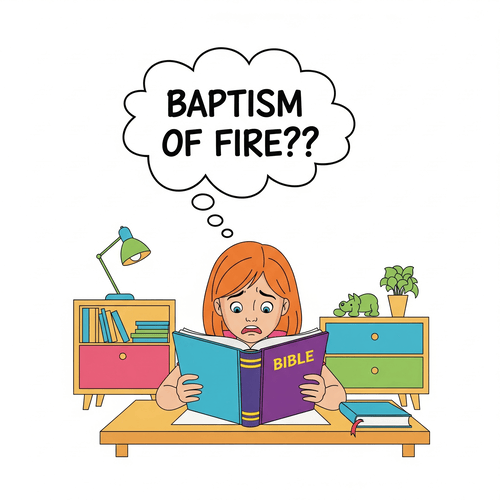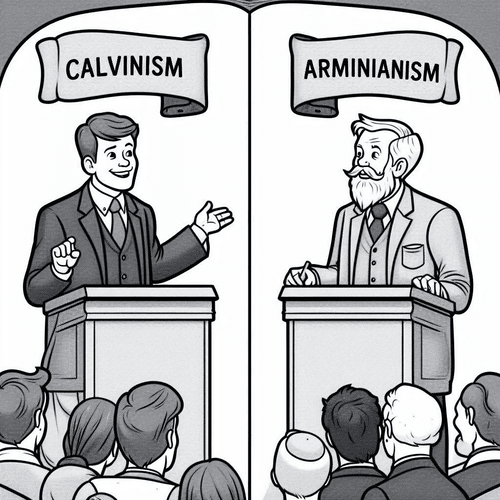Matthew 3:11: What Is the Baptism of Fire?
When John the Baptist declared, “He will baptise you with the Holy Spirit and fire” (Matthew 3:11), his words carried the weight of both a promise and a warning. But what exactly did John mean by this “baptism of fire”?
This question profoundly affects our understanding of salvation and the Holy Spirit’s work. Some interpret the fire as spiritual empowerment or purification. But careful examination of Scripture reveals a more sobering truth: the baptism of fire refers to divine judgement, not charismatic experience. This understanding preserves both the Gospel’s urgency and God’s grace.
READING THE WARNING SIGNS
To understand John’s meaning, we must listen to his entire sermon. The religious leaders had come seeking baptism, but John’s response was hardly welcoming: “You brood of vipers! Who warned you to flee from the wrath to come?” (Matthew 3:7). This wasn’t exactly seeker-friendly church growth strategy.
John’s imagery grows increasingly stark. He speaks of an axe already positioned at the root of trees, ready to cut down those that don’t bear good fruit. The barren trees, he warns, will be “thrown into the fire” (v. 10). Then comes his declaration about Christ’s baptism with “the Holy Spirit and fire,” followed immediately by another agricultural metaphor: Christ will separate wheat from chaff with his winnowing fork, gathering wheat into his barn but burning the chaff “with unquenchable fire” (v. 12).
Notice the pattern. John isn’t painting a picture of spiritual blessing and empowerment. He’s delivering a stark ultimatum. The coming Messiah will perform the ultimate separation—some will receive the life-giving baptism of the Holy Spirit, while others will face the consuming baptism of divine judgement. The literary structure makes this clear: just as wheat and chaff represent two destinies, so “the Holy Spirit and fire” represent two different experiences of Christ’s coming.
The historical context reinforces this interpretation. Jewish audiences expected the Messiah to bring judgement on God’s enemies and vindication for the righteous. Fire consistently symbolised divine judgement throughout the Old Testament, from Sodom and Gomorrah to the imagery in Isaiah and Malachi. John was operating squarely within this prophetic tradition, warning his hearers the Messiah’s arrival meant decision time.
THE REFORMED VIEW: CHRIST AS BOTH SAVIOUR AND JUDGE
The Reformed interpretation sees John’s “baptism of fire” as divine judgement. The grammatical evidence supports this view. In the Greek text, a single article governs both “Holy Spirit” and “fire”, suggesting these aren’t two separate baptisms but two aspects of Christ’s singular work. Just as a coin has two sides, Christ’s ministry has two functions: salvation for those who repent and judgement for those who reject him.
This interpretation finds strong support in Matthew’s broader usage. Throughout his Gospel, Matthew consistently employs fire imagery to represent judgement, never blessing. Jesus speaks of hell’s fire (5:22), the furnace of fire where angels will cast the wicked (13:40), and the eternal fire prepared for the devil and his angels (25:41). If Matthew intended fire to represent blessing in chapter 3, it would be completely inconsistent with his usage everywhere else.
The Old Testament background further confirms this reading. Malachi 3:2-3 asks, “Who can endure the day of his coming? Who can stand when he appears? For he is like a refiner’s fire and like fullers’ soap.” Here, fire represents the Messiah’s purifying judgement that separates the righteous from the wicked. Similarly, Isaiah 4:4 speaks of the Lord washing away Jerusalem’s filth “by a spirit of judgement and by a spirit of burning.”
Theologically, this interpretation preserves the full scope of Christ’s work. The Gospel isn’t just about personal fulfillment or spiritual experiences—it’s about God’s holy response to human rebellion. Christ came both to save and to judge, and every person will experience one or the other. There’s no neutral ground, no third option. John’s baptism of fire reminds us the stakes couldn’t be higher.
ALTERNATIVE VIEWS AND THEIR PROBLEMS
The Pentecostal and charismatic traditions often interpret the baptism of fire as a second blessing or empowerment experience. They point to the tongues of fire at Pentecost (Acts 2:3). While we celebrate the Holy Spirit’s empowering work, this interpretation faces serious problems. First, it completely ignores the judgement context of Matthew 3. Second, it artificially separates the Holy Spirit from fire, when the grammar suggests they’re aspects of one reality. Third, it conflates two different biblical events—the tongues “as of fire” at Pentecost were a sign of the Spirit’s presence, not the fulfillment of John’s prophecy about baptism with fire.
Others suggest fire represents the Holy Spirit’s purifying work in believers’ lives. This view has more biblical support, as Scripture does speak of God’s word and Spirit purifying his people. However, the context of Matthew 3 emphasises destruction, not purification. The fire that burns the chaff doesn’t refine it—it consumes it completely. Moreover, this interpretation fails to account for the judgement theme that runs throughout John’s message.
A third view attempts to have it both ways: it argues fire represents both purification for believers and judgement for unbelievers. While this might seem to resolve the tension, it actually creates more problems. The grammar doesn’t support such a dual meaning, and it obscures the clear warning John the Baptist is delivering. If fire could mean blessing, why would the religious leaders need to “flee from the wrath to come”?
WHY THE REFORMED VIEW MAKES BETTER SENSE
The Reformed interpretation makes the best sense for several compelling reasons.
- It lets the context determine meaning. When we read Matthew 3:11 in light of verses 7-12, the judgement interpretation becomes unavoidable. Good hermeneutics demands we let the text speak on its own terms rather than importing meanings from other passages.
- It maintains theological accuracy about the Gospel’s nature. The good news isn’t just that Jesus offers blessings, but that he saves us from the judgement we deserve. Remove the fire of judgement, and you diminish the wonder of grace. The cross only makes sense against the backdrop of divine wrath against sin. John’s baptism of fire reminds us what Christ saved us from.
- It provides practical balance for Christian ministry. It maintains evangelistic urgency—people really do face eternal consequences for rejecting Christ. It promotes Christian maturity by helping believers understand both their incredible privilege and their ongoing responsibility. And it offers pastoral wisdom by avoiding false assurance while nurturing genuine faith.
THE BAPTISM OF FIRE: THE CHOICE REMAINS
John the Baptist’s message echoes across the centuries with undiminished power. Christ still comes to baptise with the Holy Spirit and fire. The question remains the same for each of us: Which baptism will you receive? Have you experienced the Spirit’s regenerating work, turning your heart of stone into a heart of flesh? Or do you face the fire of divine judgement for rejecting God’s offer of grace?
John’s baptism of fire reminds us neutrality isn’t an option. Christ’s coming demands a response. But for those who turn to him in faith and repentance, that response leads not to the fire of judgement but to the life-giving baptism of the Holy Spirit. In a world that often treats the Gospel as optional, John’s words ring out with prophetic clarity: the stakes are eternal, the choice is urgent, and the grace is sufficient.
The question isn’t whether we shall all be baptised by Christ, for everyone will be. The question is which baptism we shall receive—will it be the baptism of salvation or that of divine judgement.
THE BAPTISM OF FIRE: RELATED FAQs
What do Reformed scholars say about the baptism of fire? John MacArthur strongly advocates the judgement interpretation, emphasising the context of Matthew 3 leaves no room for viewing fire as blessing. RC Sproul similarly argued the fire represents eschatological judgement: he noted separating the Spirit from fire grammatically violates the text’s structure. Both scholars warn against the charismatic tendency to seek experiential “fire baptisms” that lack biblical foundation. Contemporary Reformed theologians like Sinclair Ferguson and Derek Thomas uphold this tradition, viewing the passage as Christ’s promise to both save and judge.
- How does the baptism of fire relate to the “baptism of suffering” Jesus mentions in Mark 10:38-39? Jesus’ reference to his “baptism” of suffering represents His coming death and the cup of God’s wrath He would drink on the cross. This connects directly to Matthew 3:11 because Christ experienced the baptism of fire (God’s judgement) on behalf of believers at Calvary. The irony is profound: Jesus underwent the fire of divine wrath so those that trust him receive the Spirit’s baptism instead. Mark’s passage shows Christ didn’t escape the baptism of fire—He endured it as our substitute.
- Why don’t some scholars accept the judgement interpretation? A minority of Reformed scholars, including some influenced by Puritan commentators like Matthew Henry, argue for a dual aspect where fire represents both purification for believers and judgement for unbelievers. They point to passages like 1 Corinthians 3:13-15 where fire tests and purifies believers’ works. However, most contemporary Reformed exegetes reject this view because it forces the grammar and context of Matthew 3. The judgement interpretation remains the dominant Reformed position because it best honours the text’s immediate context and theological consistency.
How does this interpretation affect our understanding of the final judgement? The baptism of fire provides a vivid preview of the final judgement where Christ will separate humanity definitively. Just as John described wheat and chaff separation, Revelation 20 depicts the final separation of the righteous and wicked. This means the baptism of fire isn’t just a past event but an ongoing reality that culminates in the last judgement. Every person will ultimately experience either the Spirit’s life-giving work or the consuming fire of God’s wrath—there are no other categories.
- What about the “refiners fire” in Malachi 3:2-3? Doesn’t that suggest purification rather than destruction? Malachi’s refiner’s fire does involve purification, but it’s purification through judgement that destroys impurities while preserving what’s valuable. The key difference is that Malachi addresses the covenant community, while Matthew 3 addresses a mixed audience including unrepentant religious leaders. When John the Baptist quotes this imagery, he’s emphasising the Messiah’s coming will expose and destroy what’s false while preserving the genuine. The refining process necessarily involves both preservation and destruction—the dross is completely burned away.
- How do we reconcile this view with passages that speak positively about fire, like the tongues of fire at Pentecost? Scripture uses fire imagery in different ways depending on the context, just as it uses water imagery for both blessing (cleansing) and judgement (the flood). The tongues “as of fire” at Pentecost were theophanic signs of God’s presence, similar to the burning bush or the fire on Mount Sinai. These weren’t literal fire but divine manifestations. Matthew 3:11’s fire, however, appears in a judgment context and represents actual consuming judgment. Good hermeneutics requires distinguishing between different biblical uses of the same symbol based on context.
If the baptism of fire is judgement, why do some Christians claim to have experienced it as a blessing? Sincere Christians sometimes conflate different biblical concepts, assuming any intense spiritual experience must be the “baptism of fire.” This often stems from seeking dramatic spiritual experiences rather than doing careful Bible study. The Holy Spirit does work powerfully in believers’ lives, bringing conviction, transformation, and spiritual gifts. However, these experiences should be understood as the Spirit’s ongoing sanctifying work, not fulfillment of John’s baptism of fire prophecy. True spiritual maturity comes through understanding what Scripture actually teaches rather than interpreting experiences through unbiblical categories.
THE BAPTISM OF FIRE: OUR RELATED POSTS
Editor's Pick

Faithful to the Pattern: Why Paul Reserves Ordination for Men
Few topics in contemporary Christianity generate more tension than women’s ordination. This question touches real lives, genuine callings, and deeply [...]

‘Flee Sexual Sin’: Why Does Paul Single This Sin Out?
When the apostle Paul writes to the Corinthian church, he doesn’t tell them to simply avoid sexual immorality or resist [...]

Does Denying God’s Sovereignty Mean Denying the Gospel?
RC Sproul once warned denying God’s sovereignty “eviscerates” grace—a strong word meaning to gut or disembowel something, leaving only an [...]

Why Christians Fast: The Biblical Discipline’s Very Real Rewards
Why would Christians, who rejoice in the good gifts of food and fellowship, deliberately choose to go without? Isn’t fasting [...]

The Christian Sabbath: Why Did Sunday Replace Saturday?
Consider this: God-fearing Jews who’d faithfully observed Saturday Sabbath for over a thousand years suddenly began gathering for worship on [...]

Did the Early Christians Worship Jesus? The Biblical Evidence
It was a startling transformation: Jewish fishermen who'd spent three years following this itinerant carpenter from Nazareth now begin to [...]

If Jesus is Messiah, Why Aren’t ALL Messianic Prophecies Fulfilled?
If Jesus is truly the Messiah, why hasn't world peace arrived? Why do Jews still face persecution? Why isn't the [...]

When Courage Fails: Will I Be Forgiven If I Deny Christ in Persecution?
The rooster crowed, and Peter remembered. In that devastating moment, the apostle realised he’d just done the unthinkable—three times he’d [...]

What Makes a Godly Dad? 5 Biblical Principles Fathers Need
Modern culture sends fathers mixed messages. Be strong but sensitive. Be involved but not overbearing. Lead but don’t dominate. With [...]

What Makes a Godly Mom? A Scripture-Backed Guide
In our culture’s confusion about gender roles and parenting, the timeless question remains: what makes a godly mother? While secular [...]
SUPPORT US:
Feel the Holy Spirit's gentle nudge to partner with us?
Donate Online:
Account Name: TRUTHS TO DIE FOR FOUNDATION
Account Number: 10243565459
Bank IFSC: IDFB0043391
Bank Name: IDFC FIRST BANK






